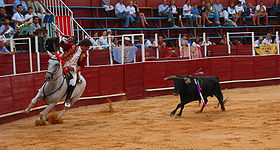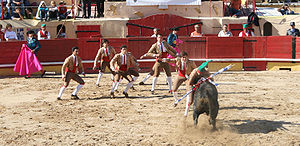
Portuguese-style bullfighting
Encyclopedia

Bullfighting
Bullfighting is a traditional spectacle of Spain, Portugal, southern France and some Latin American countries , in which one or more bulls are baited in a bullring for sport and entertainment...
differs in many aspects from Spanish-style bullfighting
Spanish-style bullfighting
Spanish-style bullfighting is called a corrida de toros , or fiesta brava. In traditional corrida, three toreros, also called matadores or, in French, toréadors, each fight two out of a total of six fighting bulls, each of which is at least four years old and weighs up to about Spanish-style...
. The cavaleiros and the forcados are unique as well as the horsewomen (cavaleiras).
Main figures
- Cavaleiros - A horseman or woman (rider), dressed in traditional 18th century costumes fights the bull from horseback. The horses are Portuguese Lusitanos, specially trained for the fights. These horses are usually skilled in dressageDressageDressage is a competitive equestrian sport, defined by the International Equestrian Federation as "the highest expression of horse training." Competitions are held at all levels from amateur to the World Equestrian Games...
and may exhibit their art in the arena. The purpose of this fight is to stab three or four bandarilhas (small javelinSpearA spear is a pole weapon consisting of a shaft, usually of wood, with a pointed head.The head may be simply the sharpened end of the shaft itself, as is the case with bamboo spears, or it may be made of a more durable material fastened to the shaft, such as flint, obsidian, iron, steel or...
s) in the back of the bull. In the past, horseback bullfighters were often members of old aristocratic families. The horsewomen (cavaleiras) are a pioneer and unique feature of the Portuguese bullfighting. Ana Batista, Sónia MatiasSónia MatiasSónica Patricia Pereira Matias is a Portuguese association football defender, currently playing for RCD Espanyol in Spain's Primera División. She previously played for SU 1º Dezembro in Portugal's Campeonato Nacional and Prainsa Zaragoza....
and Ana Rita are among the first and most renowned cavaleiras of Portugal. - Forcados - The forcadoForcadoA forcado is a member of the team that performs the pega de cara or pega de caras , the final event in a typical Portuguese bullfight...
s are a group of eight men who challenge the bull directly, without any protection or weapon of defense. The front man provokes the bull into a charge to perform a pega de cara or pega de caras (face catch). The front man secures the animal's head and is quickly aided by his fellows who surround and secure the animal until he is subdued. Forcados were usually people from lower classes who, to this day, practice their art through amateur associations. - Matadores - Same as the Spanish matadores, but they do not kill the bull in the end.
- Bandarilheiros - These men are the matador's and/or cavaleiro's helpers in the arena. They are skillful and wear the suit of light as the matador, except not with the gold sequins. While in the arena, they are holding the gold/pink cape to distract or position the bull.
Stages
Most Portuguese bullfights (corridas de touros) are held in two phases: the spectacle of the cavaleiro, followed by the pega. In Portugal, the main stars of bullfighting are the cavaleiros, as opposed to Spain, where the matadores are the most prominent bullfighters. Nevertheless, bullfights with matadores are frequent, notably with Portuguese matadores who practice their trade in Spain and who, when in Portugal, replace the sword in their final strike with a bandarilha. Examples of famous Portuguese matadores are Vítor Mendes and Pedrito de Portugal.During the cavaleiro, a horseman on a Portuguese Lusitano horse (specially trained for the fights) fights the bull from horseback. The purpose of this fight is to stab three or four bandeirilhas (small javelin
Spear
A spear is a pole weapon consisting of a shaft, usually of wood, with a pointed head.The head may be simply the sharpened end of the shaft itself, as is the case with bamboo spears, or it may be made of a more durable material fastened to the shaft, such as flint, obsidian, iron, steel or...
s) in the back of the bull.

Forcado
A forcado is a member of the team that performs the pega de cara or pega de caras , the final event in a typical Portuguese bullfight...
s, a group of eight men, challenge the bull directly without any protection or weapon of defense. The front man provokes the bull into a charge to perform a pega de cara or pega de caras (face catch). The front man secures the animal's head and is quickly aided by his fellows who surround and secure the animal until he is subdued. Many people who watch Portuguese-style bullfights in the United States use the term, "suicide squad", to refer to this group of eight men.
The bull is not killed in the ring and, at the end of the corrida, leading oxen are let into the arena and two campinos on foot herd the bull along them back to its pen. The bull is usually killed, away from the audience's sight, by a professional butcher. Some bulls, after an exceptional performance, are restored to health and released to pasture for breeding. Nevertheless, tradition was so strong at the small frontier town of Barrancos
Barrancos
Barrancos is a municipality in Portugal with a total area of 168.3 km² and a total population of 1,825 inhabitants.The municipality is composed of one parish, being one of the six Portuguese municipalities composed of only one parish, and is located in Beja District, close to the Spanish...
, where the bull was illegally put to death in the arena, that the government was forced to relent and permit the town to follow its ancient matador tradition and kill the bull in the arena.
There are other forms of traditional bullfighting in Portugal, some differing markedly from the version described above. In the Azores
Azores
The Archipelago of the Azores is composed of nine volcanic islands situated in the middle of the North Atlantic Ocean, and is located about west from Lisbon and about east from the east coast of North America. The islands, and their economic exclusion zone, form the Autonomous Region of the...
, bullfighting is often reminiscent of the running of the bulls in Pamplona
Pamplona
Pamplona is the historial capital city of Navarre, in Spain, and of the former kingdom of Navarre.The city is famous worldwide for the San Fermín festival, from July 6 to 14, in which the running of the bulls is one of the main attractions...
(Spain) in the respect that those most at risk are human beings, not the bulls themselves. The Azorean style involves a group of people vying in a tug-of-war with a young bull by holding fast to a long stout rope tied around the bull's neck. This is called the tourada à corda (bull-on-a-rope 'game').
Hazards
In Portugal, some bulls have their horns severed and covered in a way that they do not present sharp points. This practice is believed to have been introduced by King Joseph I of Portugal after a tragic event in a bullfight he was presiding at Salvaterra de MagosSalvaterra de Magos
Salvaterra de Magos is a municipality in Portugal with a total area of 244,74 km² and a total population of 22,053 inhabitants.The municipality is composed of 6 parishes, and is located in the district of Santarém....
. The son and heir of the 4th Marquis of Marialva
Marquis of Marialva
Count of Cantanhede was a Portuguese title of nobility created by a royal decree, dated from August 6, 1479, by King Afonso V of Portugal, and granted to D. Pedro de Menezes, 5th Lord of Cantanhede....
was fighting a bull on horseback when the animal wounded his horse. The young man fell, was kicked by the bull and killed. The Marquis himself, then around 70 years of age, jumped from the royal cabin that he shared with the king, drew his sword and killed the animal.
History
The Portuguese now practise a type of bullfighting which is in many respects different from its original form. An idea of the original form can be constructed from the Spanish style.In 1836, due to the action of queen Mary II, Portugal deemed the killing of bulls to be immoral, and they passed a law banning the public killing of bulls. However, this law only lasted for a year; the next time a law was passed prohibiting the public killing of bulls was in 1928.
The Portuguese Parliament made a specific bullfight to the death (Barrancos) legal again in 2002, saying that it has been a social tradition (a rare example of custom with law relevancy in the Portuguese legal system). Previously when the Portuguese government deemed it illegal to kill the bulls, there was a great social outcry to re-legalize this specific practice. In contrast, there was again a social outcry in 2002, but this time to keep killing the bulls in the fights illegal.
Geographic Distribution
The southern and central regions of Portugal, such as Ribatejo
Ribatejo
The Ribatejo is the most central of the traditional provinces of Portugal, with no coastline or border with Spain. The region is crossed by the Tagus River...
and Alentejo, and Terceira Island
Terceira Island
Referred to as the “Ilha Lilás” , Terceira is an island in the Azores archipelago, in the middle of the North Atlantic Ocean. It is one of the larger islands of the archipelago, with a population of 56,000 inhabitants in an area of approximately 396.75 km²...
in the Azores, are traditionally more interested in the corrida de touros. In Portugal's northern regions, bullfighting have a lower presence.

